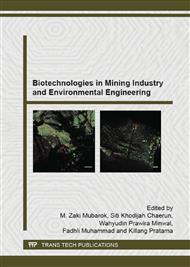p.3
p.7
p.11
p.15
p.19
p.23
p.28
p.32
p.36
Screening and Isolation of Bacterial Strains with the Biotechnological Potential to Destruct Cyanide-Bearing Compounds under the Conditions of Extreme Continental Climate
Abstract:
The methods of biodegradation are of special interest because they help solving environmental problems of wastes detoxification from gold-mining operations. The use of bacterial strains is a promising approach in the field of biotechnology to destruct cyanide-bearing compounds. The diversity of microbial communities both in heap in situ and in the enriched cultures was studied with molecular genetic methods. The differences in representation of bacteria, cultivated in unexploitable and operating heaps, are territory, site and heap specific. The strains of Pseudomonas sp. and Methylobacterium sp. possess the biotechnological potential and might be used in biodegradation of heap leaching wastes in extreme continental climate.
Info:
Periodical:
Pages:
19-22
Citation:
Online since:
November 2015
Authors:
Keywords:
Price:
Сopyright:
© 2015 Trans Tech Publications Ltd. All Rights Reserved
Share:
Citation:


